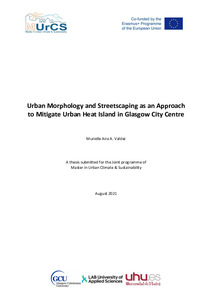Urban morphology and streetscaping as an approach to mitigate urban heat island in Glasgow city centre
Valdez, Murielle Aira A. (2021)
Valdez, Murielle Aira A.
2021
All rights reserved. This publication is copyrighted. You may download, display and print it for Your own personal use. Commercial use is prohibited.
Julkaisun pysyvä osoite on
https://urn.fi/URN:NBN:fi:amk-2021102919047
https://urn.fi/URN:NBN:fi:amk-2021102919047
Tiivistelmä
The urban heat island or UHI is perhaps one of the most apparent consequences of climate change in cities. UHI is characterised as an urban area that is considerably warmer than its surrounding [Oke, 2017]. This phenomenon occurs mainly due to population increase, which associates with many factors, such as the construction of new structures, emission build-up from motor vehicles, and demand for urban environments. Although densification affects the city’s environmental condition, many studies have recognised it as a key to sustainability since it prevents the further expansion of built-up urban areas. Thus, there is a need for UHI mitigation strategies in order to stop the anticipated effects of urbanisation.
One of the cities that have been experiencing climate change over the last century is Glasgow. Being the most urbanised city in Scotland, Glasgow is not far from facing intense UHI in the near future, especially since the local authority plans to double its population by the year 2050. Currently, Glasgow is implementing action plans to adapt to climate change and integrate sustainable spatial strategies, such as placemaking initiatives, streetscape improvement projects, and preservation of heritage buildings. This dissertation analyses the impacts of UHI in Glasgow through an urban form modification approach, taking into account the urban morphology and streetscaping of the city centre. Urban morphology is the study of urban form [Lilley, 2009]. For this purpose, the thesis critically assessed two key streets to use as objects of study in implementing the urban form modification and the streetscape improvement plan using simulation software. Because of the emergence of UHI, many related studies have recognised the benefits of simulation software in understanding better the UHI impacts on a local scale. Likewise, aspect ratio and sky view factor (SVF) were essential in answering the main objectives of this dissertation since these are two commonly used indicators of urban morphology.
With the help of fieldwork and experimental research, this thesis has observed several key findings: (1) An open geometry, or high SVF, does not always favour urban areas, especially if the environment incorporates impermeable surfaces and lacks green infrastructure. (2) Although street orientation has a significant influence on air temperature, the aspect ratio has a stronger correlation to it. Regarding the latter observation, this thesis proves that (3) increasing the aspect ratio could lead to a decrease in the incoming solar radiation, thus cooling the temperature during the day. (4) Of all the streetscaping elements, urban trees demonstrate the optimum benefit in cooling the microclimate. Next is shading, and the least benefit is observed in surface materials. Therefore, these findings conclude that incorporating urban morphology and streetscaping is sufficient in managing UHI in Glasgow. Moreover, this thesis demonstrates the importance of an integrated approach in UHI mitigation schemes on a local scale.
One of the cities that have been experiencing climate change over the last century is Glasgow. Being the most urbanised city in Scotland, Glasgow is not far from facing intense UHI in the near future, especially since the local authority plans to double its population by the year 2050. Currently, Glasgow is implementing action plans to adapt to climate change and integrate sustainable spatial strategies, such as placemaking initiatives, streetscape improvement projects, and preservation of heritage buildings. This dissertation analyses the impacts of UHI in Glasgow through an urban form modification approach, taking into account the urban morphology and streetscaping of the city centre. Urban morphology is the study of urban form [Lilley, 2009]. For this purpose, the thesis critically assessed two key streets to use as objects of study in implementing the urban form modification and the streetscape improvement plan using simulation software. Because of the emergence of UHI, many related studies have recognised the benefits of simulation software in understanding better the UHI impacts on a local scale. Likewise, aspect ratio and sky view factor (SVF) were essential in answering the main objectives of this dissertation since these are two commonly used indicators of urban morphology.
With the help of fieldwork and experimental research, this thesis has observed several key findings: (1) An open geometry, or high SVF, does not always favour urban areas, especially if the environment incorporates impermeable surfaces and lacks green infrastructure. (2) Although street orientation has a significant influence on air temperature, the aspect ratio has a stronger correlation to it. Regarding the latter observation, this thesis proves that (3) increasing the aspect ratio could lead to a decrease in the incoming solar radiation, thus cooling the temperature during the day. (4) Of all the streetscaping elements, urban trees demonstrate the optimum benefit in cooling the microclimate. Next is shading, and the least benefit is observed in surface materials. Therefore, these findings conclude that incorporating urban morphology and streetscaping is sufficient in managing UHI in Glasgow. Moreover, this thesis demonstrates the importance of an integrated approach in UHI mitigation schemes on a local scale.
